How to Caramelize Onions
Caramelized onions add something special to so many different meals! I’ll show you how to caramelize onions the right way, for onions that are sweet, dark, and jammy.
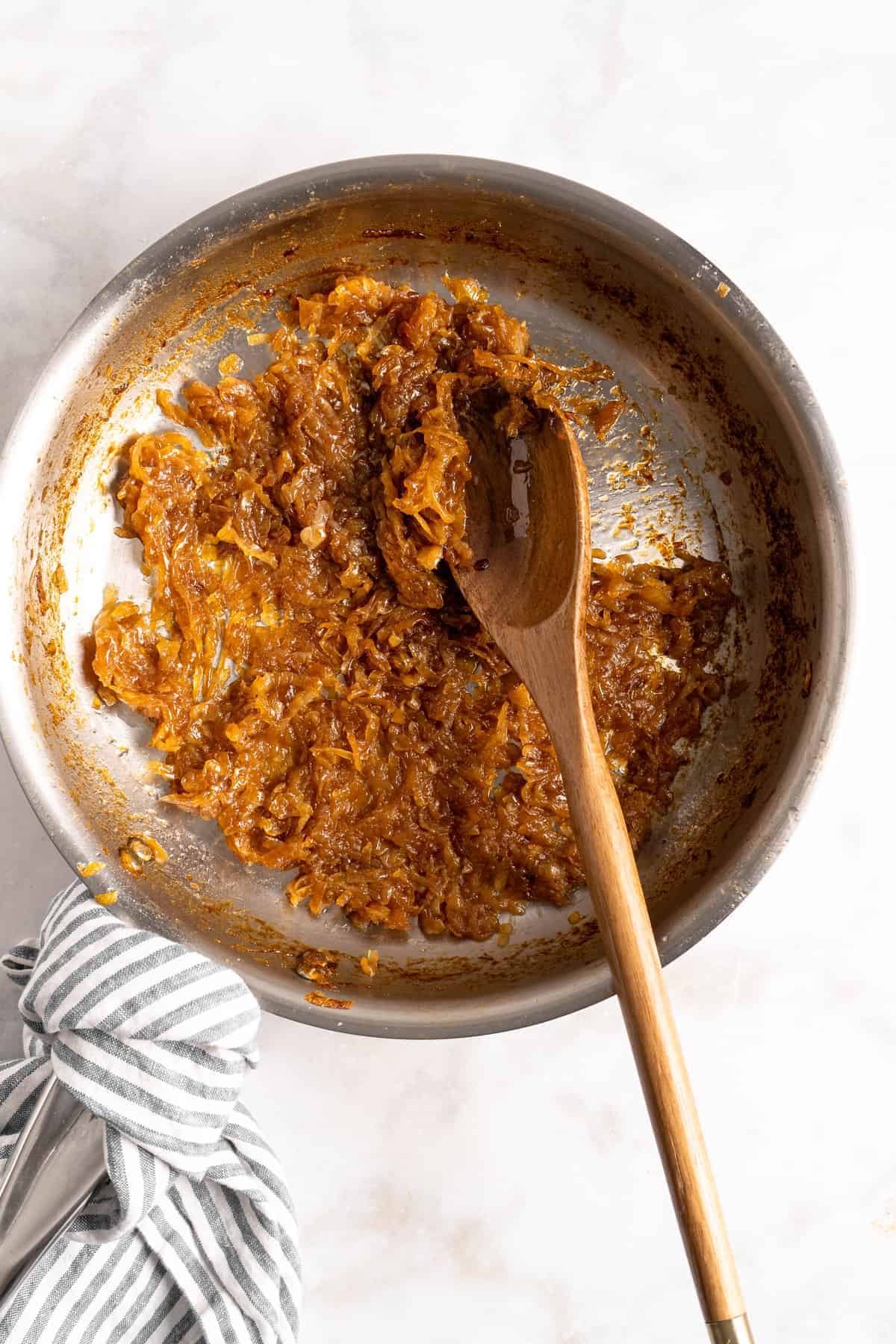
Caramelized onions are one of my favourite things to add to everything from pizza and burgers to a frittata. They take the meal to the next level! Unfortunately, a lot of recipes have you rushing the process—and let’s be honest here, you’re not going to caramelize onions by cooking them over medium-high heat for 10 minutes. Sautéed onions are just fine, but caramelized onions? Well, they’re pretty much magical. Once you know how to caramelize onions, the world is your oyster.
What’s the Secret to Caramelized Onions?
- Low and slow cooking. Caramelized onions take patience and time. Luckily, you’ll be rewarded in the end with sweet, jammy onions to add to ALL THE THINGS.
- Perfectly browned. As you slowly cook the onions, they soften and sweeten. The colour darkens and the flavour becomes more complex, similar to roasting garlic.
- Make a big batch. Now, not everyone has 45 minutes to make caramelized onions for a weeknight dinner. I get it! The good news is that you can make a big batch of caramelized onions and keep them in the fridge to use throughout the week. You can also freeze caramelized onions, and they’re just as delicious when thawed and reheated.
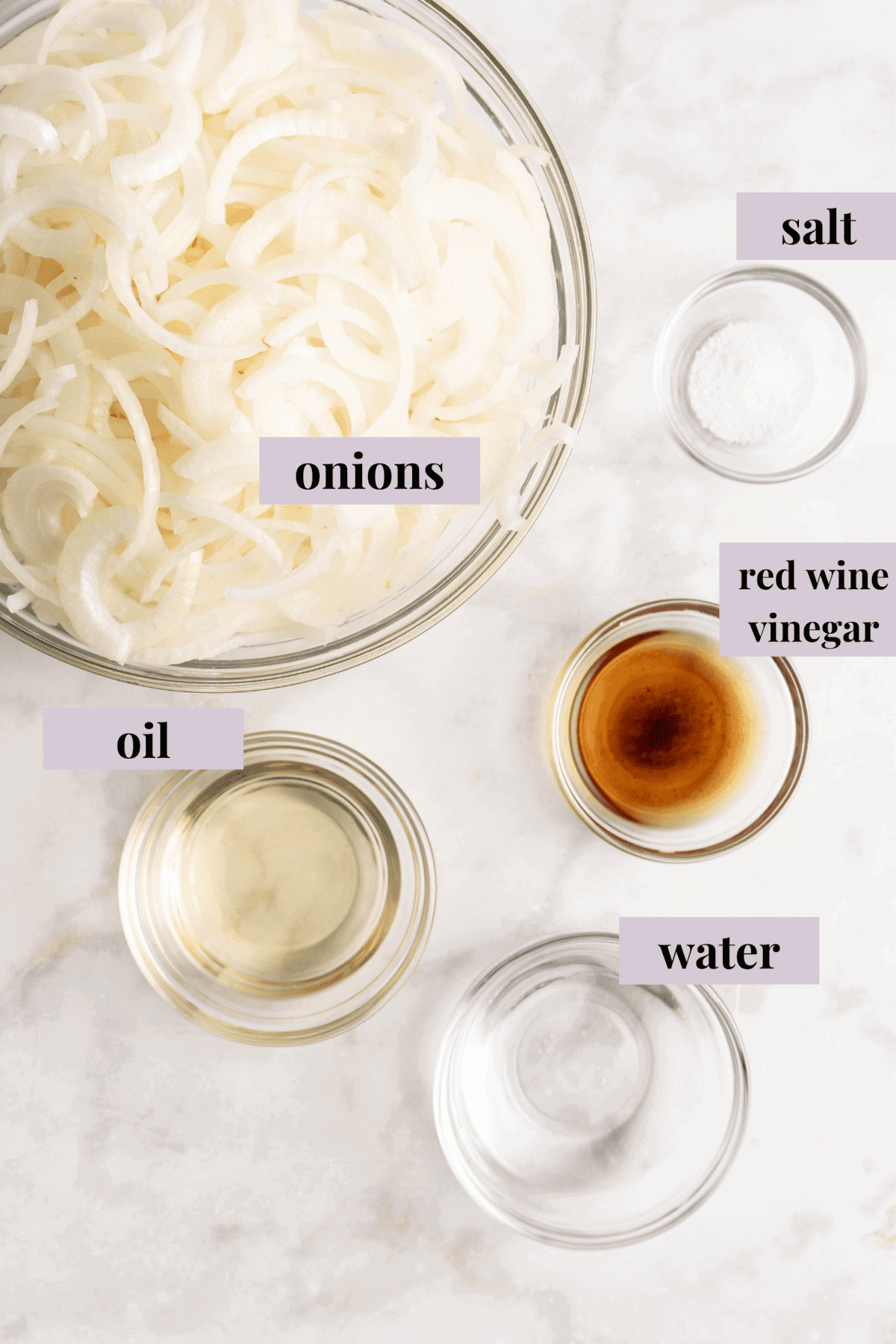
Notes on Ingredients
Please note that this is important information on the ingredients and instructions, and the FULL recipe with amounts and details can be found DOWN BELOW (scroll to it) in the recipe card.
- Oil – I usually use olive oil, but another neutral-flavored cooking oil will work.
- Onions – You can do it without them! When caramelizing onions, the type of onion matters. See below. You’ll want to slice the onions thinly, making sure they’re uniform in size.
- Red wine vinegar or red wine – Vinegar is optional, but I like to add it to season the onions and brighten the flavor in addition to sea salt.
What Onions Are Better for Caramelizing?
Yellow onions are the best and most common choice for caramelized onions. They’re what I used in this recipe. Yellow onions are naturally a bit sweet and readily available, and they also won’t turn to mush when cooked for longer periods of time.
You can also caramelize white, red, and sweet onions and shallots, too. Softer onions may need less time to cook.
How to Caramelize Onions
Once you have the time and the ingredients listed above, you’re ready to make caramelized onions! Here’s the only tutorial you’ll need on how to caramelize onions, step-by-step.
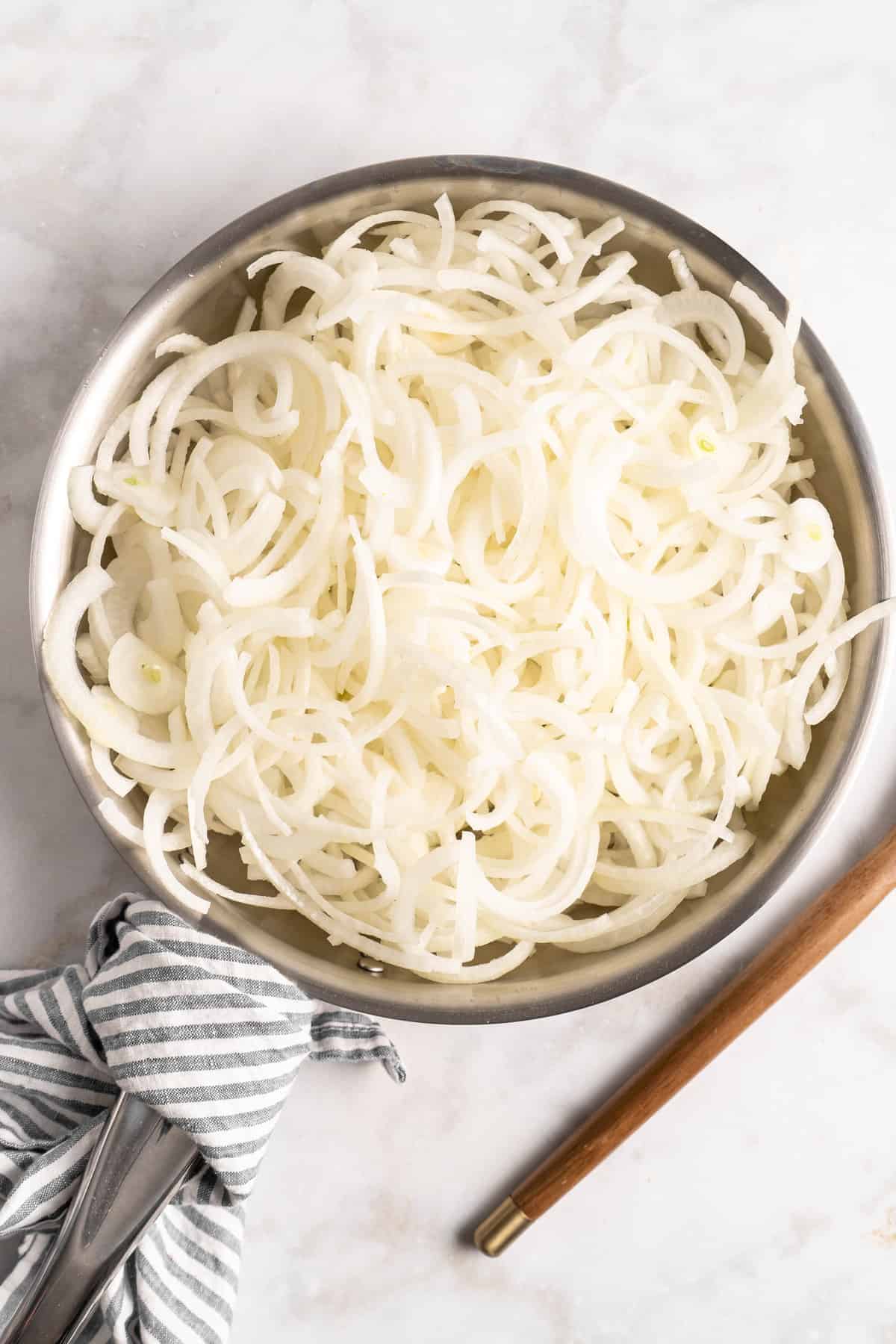

- Heat the oil. Set a large, heavy skillet over medium heat and add the oil.
- Add the onions. Place the onions in the skillet and stir them to ensure they’re all coated with the oil. Stir in a pinch of salt.
- Sauté. Cook the onions over medium heat for 5 to 8 minutes, or until they’re translucent. Reduce the heat to medium-low.
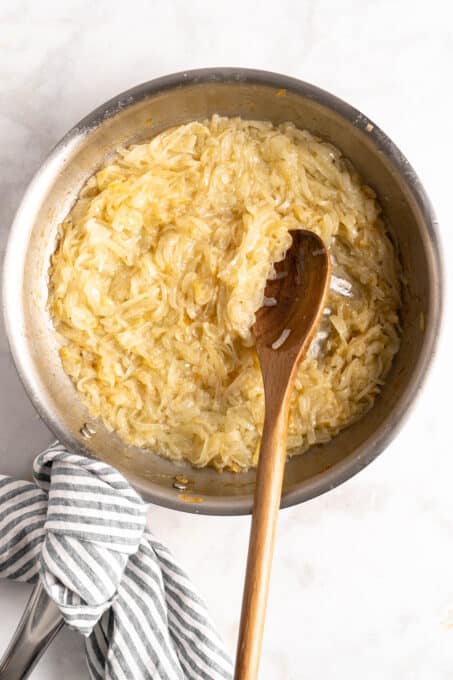
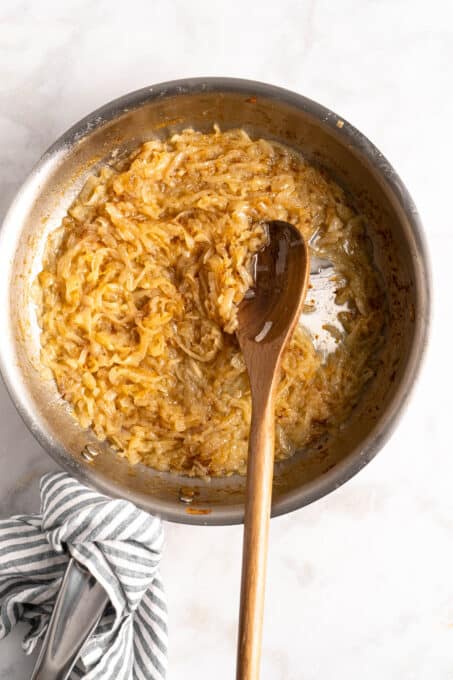
- Now, we wait. Or, wait and stir. Let the onions cook until they reach your desired depth of colour—this should take about 30 minutes, but it can vary depending on your stove and the colour or texture you’re after. Stir occasionally, and if the onions begin to get dry, add a splash of water to keep them moist and deglaze the pan.
- Finish. Just before the onions are done, add a splash of red wine vinegar to deglaze the pan and add flavour. Remove the pan from the stovetop and use the onions immediately or let them cool before storing.
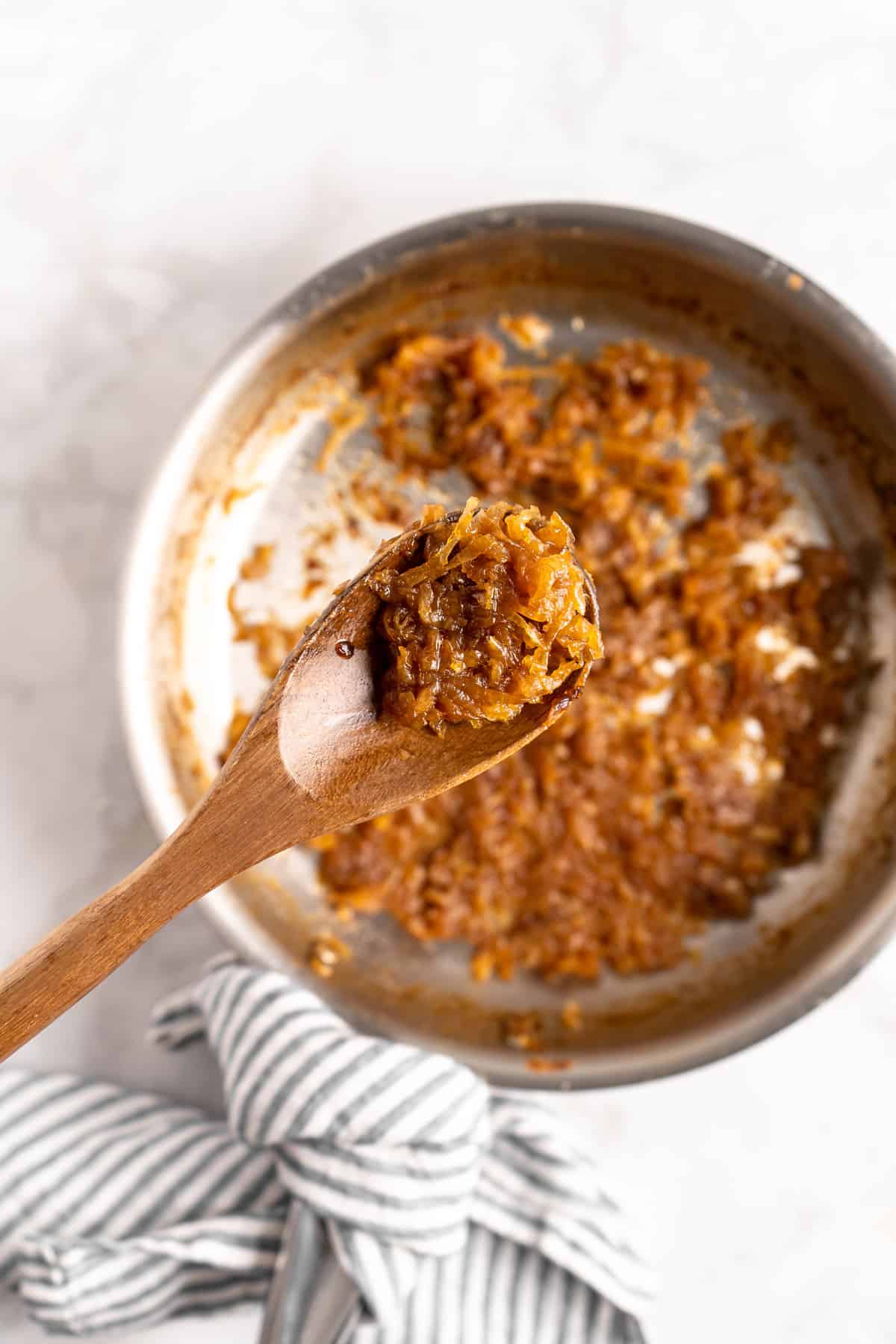
Recipe Tips
- Cut the onions evenly. If your onion slices vary in thickness, they won’t cook evenly or be done at the same time.
- Scrape and deglaze the pan. When the onions begin to brown, they’ll start to leave a fond (the technical term for the little browned bits) on the bottom of the pan. Scrape this fond when it forms (a splash of water will help release it) and swirl it back into the onions. This helps give your onions that deep, dark colour and adds so much flavour!
- Use a large, wide pan. This allows the onions to spread out and cook evenly.
Frequently Asked Questions
It’s not necessary. Covering the onions while they cook traps the steam, which can help them soften more quickly. However, I prefer to leave them uncovered, firstly, so I can keep an eye on them, and secondly, so the onions don’t turn out watery.
If you’d like, you can sprinkle a small amount (about 1 teaspoon) of sugar over the onions while they cook to help them caramelize.
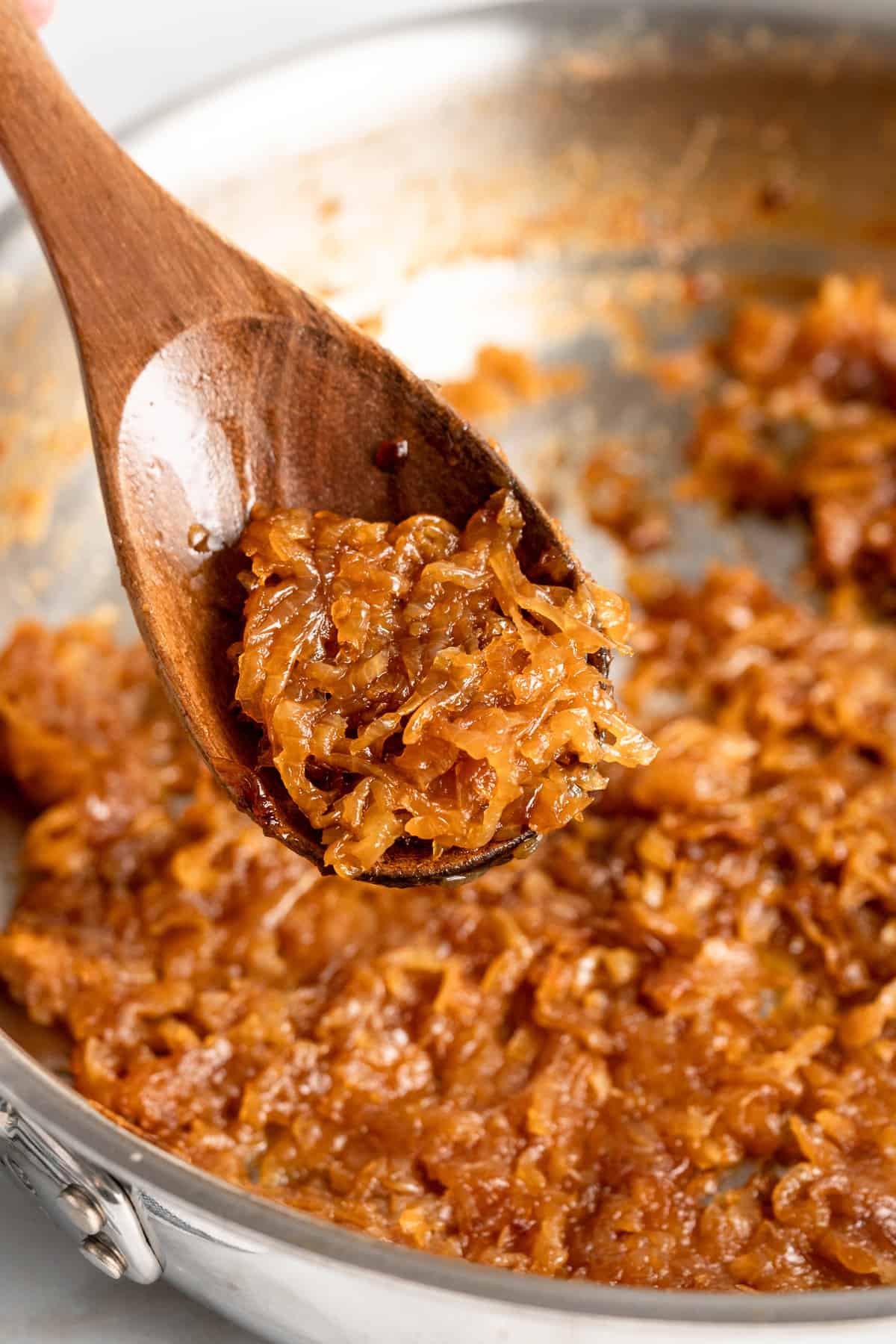
Ways to Use Caramelized Onions
I mentioned it earlier, but a great way to prepare these onions is to cook a big batch at once so you can store them to add to meals and recipes. Here are my favourite ways to put caramelized onions to use:
- Use them as a topping for burgers.
- Make them into caramelized onion dip.
- Use them to add flavour to pasta sauce.
- Add a spoonful to hummus before serving.
- Layer them with vegan cheese and bread for an epic grilled cheese sandwich.
- Top BBQ chickpea tacos with a spoonful of caramelized onions.
- Spread them onto pieces of toasted baguette.
- Have onions already caramelized to make a quick French onion soup.

How to Store Caramelized Onions
- Refrigerate. You can store caramelized onions in an airtight container in the refrigerator for up to a week.
- Freeze. You can freeze caramelized onions for up to 3 months. Freeze them flat in a freezer bag or place them in an airtight container. Let them thaw in the refrigerator before using.
Enjoy friends! If you make this caramelized onion recipe, please snap a photo and tag #jessicainthekitchen on Instagram! We’d also love it if you would leave a comment below, and give the recipe a rating! Thanks so much!
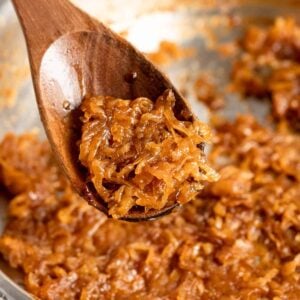
How to Caramelize Onions
Ingredients
- 2-3 tablespoons oil
- 1 lb onions, about 5 large yellow onions, sliced
- ½ teaspoon sea salt
- water, see instructions
- 2 tablespoons red wine vinegar or red wine, optional
Instructions
- In a large pan over medium heat, heat the oil.
- Add the onion slices and stir together to ensure the onions are fully coated. Add a pinch of salt and stir again.
- Saute the onions for about 5-8 minutes until the onions begin to slowly become translucent. Reduce the heat to medium low.
- Continue to stir onions every now and then. If/when the onions begin to get dry, add a splash of water (about 2 tablespoons of water a time) to deglaze the pan and ensure onions don’t stick.
- While stirring, ensure you’re always scraping the fond off the bottom and swirling it back into the onions! This gives it beautiful flavour. Continue to scrape for about 30 more minutes until the onions are the colour and texture you desire.
- In the last few minutes, add a splash of red wine vinegar for a flavour burst, swirling it into the onions. Remove from the stove and allow to cool.
- Serve immediately or store in a tupperwater container in your fridge for up to a week. Enjoy!
Notes
How to Freeze: Freeze caramelized onions for up to 3 months in a freezer bag or in an airtight container. Let them thaw in the refrigerator before using.
Disclaimer: Although jessicainthekitchen.com attempts to provide accurate nutritional information, kindly note that these are only estimates. Nutritional information may be affected based on the product type, the brand that was purchased, and in other unforeseeable ways. Jessicainthekitchen.com will not be held liable for any loss or damage resulting for your reliance on nutritional information. If you need to follow a specific caloric regimen, please consult your doctor first.




Finally, the TRUTH about caramelizing onions. So many recipes say 10 minutes. They lie!!! Thank you!
Hi Pat. Lol, thanks so much for reading!
YES!!! This is how I was initially taught; however, the restaurant where I worked needed them done in large batches and as quickly as possible. Melt the butter in the pan, add the sliced onions, sauté them with a regular stir on medium-high heat, de-glaze the pan with Chardonnay, let boil down, remove from heat, allow to cool, and package them up for the fridge until they were needed on the line.
That’s not caramelized onions. That’s sautéed onions. Sigh…quantity over quality, I guess. Bleh.
Thank you Cap’n Dave! We’re so happy that you approve!
How long can they be in the fridge? Or can they be frozen? We only have them once a week.
Hi Kay thank you so much for reading. Caramelized onions last for 2 – 3 weeks if you use fresh onions. I hope this helps.
Okay, this one is super simple that it may seem strange to have used it – but I actually got restaurant-style caramelized onions by trying this! Beforehand, my onions would randomly look burnt in places and I wasn’t drawing out the sweetness. Now they are a rich brown, sweet, and the red-wine kick helps (though most times I just add a spoon of sugar to give me the sweetness)
Aww yay this is exactly what I was hoping!! So happy you got some amazing quality caramelised onions with this!! Thanks so much for your comment Shakti!!
Thank you so much for this recipe! I also love caramelized onions, especially in dip, and this recipe was perfect!!
Thank you so much Meaghan! We’re so happy that you enjoyed the recipe, we love putting this in our dips!
Caramelized onions are one of the most amazing things in the world! They are delicious on almost anything. One of my favorite ways to use them is on homemade vegan pizza. I don’t even need cheese with these babies! Lots of people probably don’t know that to get them truly decadent, you have to have a long low cook time. Thanks for sharing your wisdom.
Thanks so much Jessica! We love caramelized onions too!
I’m excited to try this!! You give me confidence to get back into the kitchen. I’m looking to add them on a philly steak and cheese sandwich that I also will be making for the first time.
Thank you for sharing!!